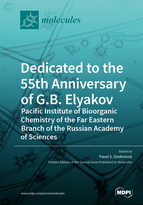Dedicated to the 55th Anniversary of G.B. Elyakov Pacific Institute of Bioorganic Chemistry of the Far Eastern Branch of the Russian Academy of Sciences
A special issue of Molecules (ISSN 1420-3049). This special issue belongs to the section "Natural Products Chemistry".
Deadline for manuscript submissions: closed (10 March 2021) | Viewed by 37852
Special Issue Editor
Interests: marine natural products; mass spectrometry; chemical structures; metabolomics; proteomics
Special Issues, Collections and Topics in MDPI journals
Special Issue Information
Dear Colleagues,
Recently, the G.B. Elyakov Pacific Institute of Bioorganic Chemistry (PIBOC) celebrated its 55th anniversary. Over many years, we have been carrying out studies on the natural products of a both marine and terrestrial origin. In collaboration with many Russian and Foreign scientists, we have investigated diverse biomolecules, including steroids and terpenoids, quinoid compounds and alkaloids, polysaccharides and lipids, enzymes and lectins, proteins, and peptides. Many living creatures such as higher plants, algae, marine invertebrates, marine bacteria, and fungi have been examined as sources of biologically active compounds, and numerous new species have been described, predominantly marine microorganisms. The biological activities of natural compounds were also studied. Long-term research at PIBOC have covered the fields of bioorganic chemistry, biochemistry, molecular immunology, organic synthesis of natural compounds, marine microbiology, genetic engineering, botany, and biotechnology. The conference, dedicated to the 55th anniversary of the G.B. Elyakov Pacific Institute of Bioorganic Chemistry, was held in Vladivostok on 11–15 September 2019, with the participation of scientists from other Scientific Institutions and Universities of our country. In accordance with the decision and sponsor support of the International scientific journal of Molecules, a Special Issue of Molecules will be submitted. We invite all participants of this conference, as well as all collaborators and friends of our institute take a part in preparing this Issue.
We hope that new scientific articles about the isolation, structures, properties, and biogenesis of biomolecules; new methods and approaches to their study, which should be prepared on the basis of lectures presented at the conference; and the studies of the scientific teams collaborating with us will be of interest for readers of Molecules.
Dr. Pavel S. Dmitrenok
Guest Editor
Manuscript Submission Information
Manuscripts should be submitted online at www.mdpi.com by registering and logging in to this website. Once you are registered, click here to go to the submission form. Manuscripts can be submitted until the deadline. All submissions that pass pre-check are peer-reviewed. Accepted papers will be published continuously in the journal (as soon as accepted) and will be listed together on the special issue website. Research articles, review articles as well as short communications are invited. For planned papers, a title and short abstract (about 100 words) can be sent to the Editorial Office for announcement on this website.
Submitted manuscripts should not have been published previously, nor be under consideration for publication elsewhere (except conference proceedings papers). All manuscripts are thoroughly refereed through a single-blind peer-review process. A guide for authors and other relevant information for submission of manuscripts is available on the Instructions for Authors page. Molecules is an international peer-reviewed open access semimonthly journal published by MDPI.
Please visit the Instructions for Authors page before submitting a manuscript. The Article Processing Charge (APC) for publication in this open access journal is 2700 CHF (Swiss Francs). Submitted papers should be well formatted and use good English. Authors may use MDPI's English editing service prior to publication or during author revisions.
Keywords
- bioorganic chemistry
- biochemistry
- molecular immunology
- organic synthesis
- marine microbiology
- genetic engineering
- botany
- biotechnology
- natural products
- biomolecules
- higher plants
- algae
- marine invertebrates
- marine bacteria
- fungi
- marine microorganisms
- steroids
- terpenoids
- quinoid compounds
- alkaloids
- polysaccharides
- lipids







